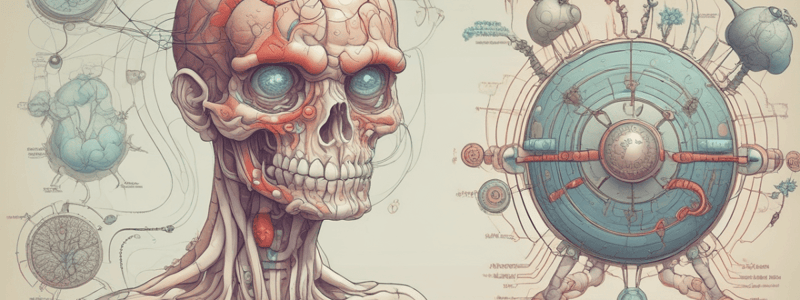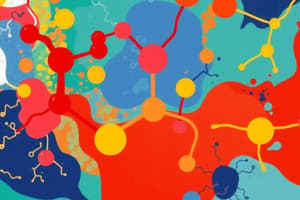Podcast
Questions and Answers
Which of the following is secreted by endocrine glands?
Which of the following is secreted by endocrine glands?
- Digestive enzymes
- Earwax
- Sweat
- Hormones (correct)
Which of these glands are exocrine?
Which of these glands are exocrine?
- Adrenal gland
- Thyroid gland
- Pituitary gland
- Salivary glands (correct)
Which chemical class of hormone is known to bind intracellular or nuclear receptors?
Which chemical class of hormone is known to bind intracellular or nuclear receptors?
- Lipid-soluble hormones (correct)
- Glycans
- Water-soluble hormones
- Lipids derived from cholesterol
What is a characteristic of thyroid hormones?
What is a characteristic of thyroid hormones?
Which of the following is NOT an example of an exocrine gland product?
Which of the following is NOT an example of an exocrine gland product?
What is the role of transport proteins in the action of lipid-soluble hormones?
What is the role of transport proteins in the action of lipid-soluble hormones?
Which of the following hormones is derived from arachidonic acid?
Which of the following hormones is derived from arachidonic acid?
Which body system uses nitric oxide as a hormone and neurotransmitter?
Which body system uses nitric oxide as a hormone and neurotransmitter?
Where do water-soluble hormones bind in a cell?
Where do water-soluble hormones bind in a cell?
Which of the following is NOT an amine hormone?
Which of the following is NOT an amine hormone?
Which hormone interaction involves two hormones having opposite effects?
Which hormone interaction involves two hormones having opposite effects?
Which hormone interaction requires a second hormone to strengthen the effects of the first?
Which hormone interaction requires a second hormone to strengthen the effects of the first?
Which of the following hormones is involved in stimulating glycogen breakdown?
Which of the following hormones is involved in stimulating glycogen breakdown?
How is hormone secretion primarily regulated?
How is hormone secretion primarily regulated?
Which feedback mechanism is most commonly used to regulate hormone levels?
Which feedback mechanism is most commonly used to regulate hormone levels?
What types of disorders can result from hormone imbalances?
What types of disorders can result from hormone imbalances?
Flashcards are hidden until you start studying
Study Notes
Water-Soluble Hormones
- Bind to receptors in the plasma membrane of a cell.
Amine Hormones
- Include serotonin, melatonin, histamine, epinephrine, and norepinephrine (catecholamines).
Peptide and Protein Hormones
- Include all hypothalamic releasing and inhibiting hormones.
- Examples: oxytocin, growth hormone, thyroid-stimulating hormone, adrenocorticotropic hormone, follicle-stimulating hormone, luteinizing hormone, prolactin, melanocyte-stimulating hormone, insulin, glucagon, somatostatin, pancreatic polypeptide, parathyroid hormone, calcitonin, gastrin, secretin, cholecystokinin, and erythropoietin.
Action of Water-Soluble Hormones
- Eicosanoids are involved.
Hormone Interactions
Permissive Effect
- A second hormone strengthens the effects of the first, e.g., thyroid hormone strengthens epinephrine's effect on lipolysis.
Synergistic Effect
- Two hormones act together for a greater effect, e.g., estrogen and luteinizing hormone (LH) are both needed for oocyte production.
Antagonistic Effects
- Two hormones have opposite effects, e.g., insulin promotes glycogen formation, while glucagon stimulates glycogen breakdown.
Control of Hormone Secretion
- Regulated by signals from the nervous system, chemical changes in the blood, or by other hormones.
Negative Feedback Control
- The most common type, where a decrease or increase in blood level is reversed.
Positive Feedback Control
- The change produced by the hormone causes more hormones to be released.
Disorders
- Involve either hyposecretion or hypersecretion of a hormone.
Glands
Exocrine Glands (Ducted Glands)
- Secrete substances into ducts, which empty into body cavities or the body surface.
- Examples: sweat glands, oil glands, earwax glands, salivary glands, and pancreas.
Endocrine Glands (Ductless Glands)
- Secrete hormones into the bloodstream.
- Examples: pituitary, thyroid, parathyroid, adrenal, and pineal glands.
- Regulate metabolic and physiological activities to maintain homeostasis.
Chemical Classes of Hormones
Lipid-Soluble Hormones
- Include steroids, thyroid hormones, eicosanoids, and nitric oxide.
- Use transport proteins and bind to intracellular or nuclear receptors.
Water-Soluble Hormones
- Include peptides, 5-HT, peptides/proteins, and glycans.
- Circulate in plasma and bind to receptors on the cell membrane.
Hormones
- Affect only specific target tissues with specific receptors.
- Various cells respond differently to the same hormone.
- Receptors are constantly synthesized and broken down, leading to down-regulation or up-regulation.
Action of Lipid-Soluble Hormones
- Free hormone diffuses into the cell through the blood capillary.
- The hormone binds to a receptor in the cytosol, forming an activated receptor-hormone complex.
- The complex alters gene expression, leading to the synthesis of specific proteins on ribosomes.
Studying That Suits You
Use AI to generate personalized quizzes and flashcards to suit your learning preferences.




